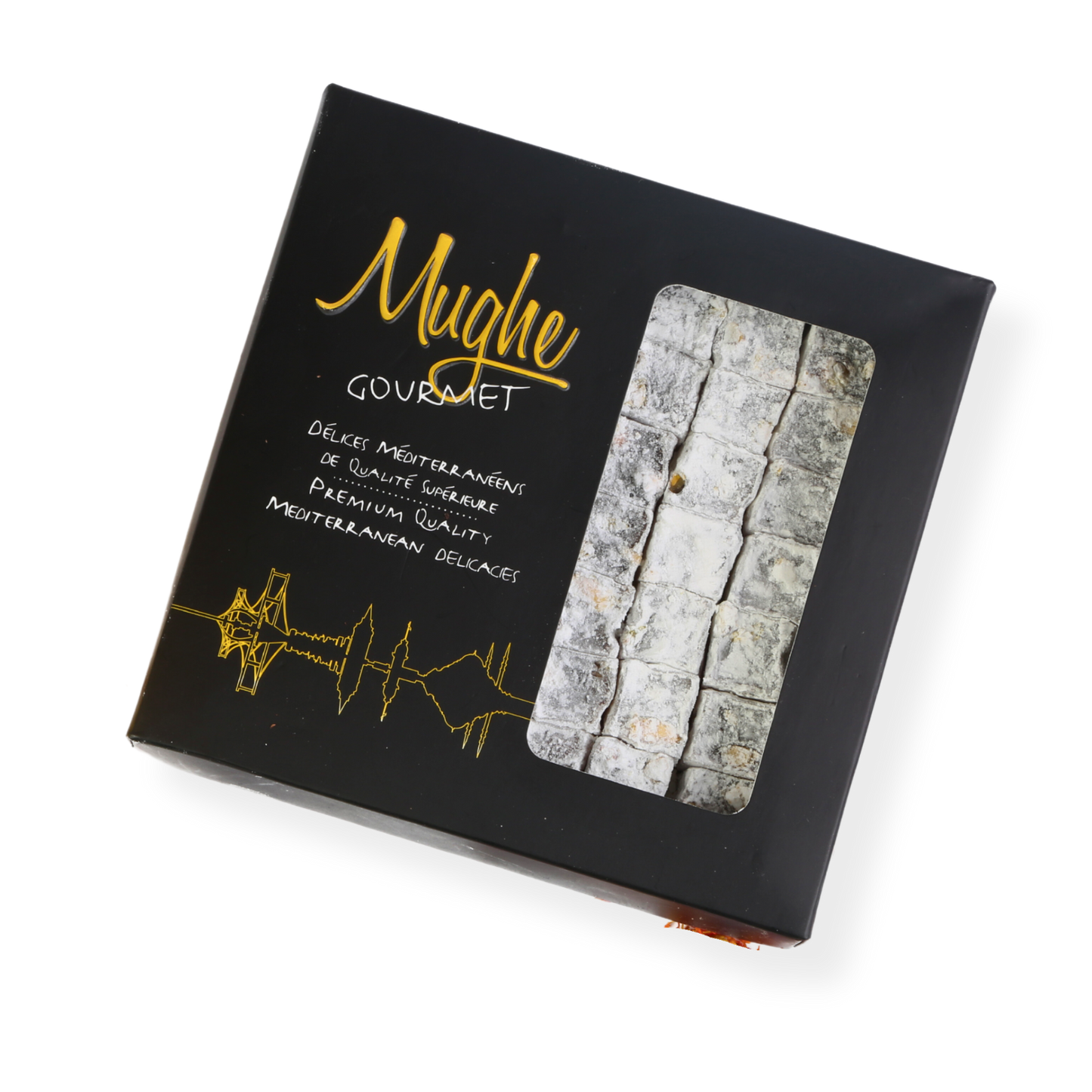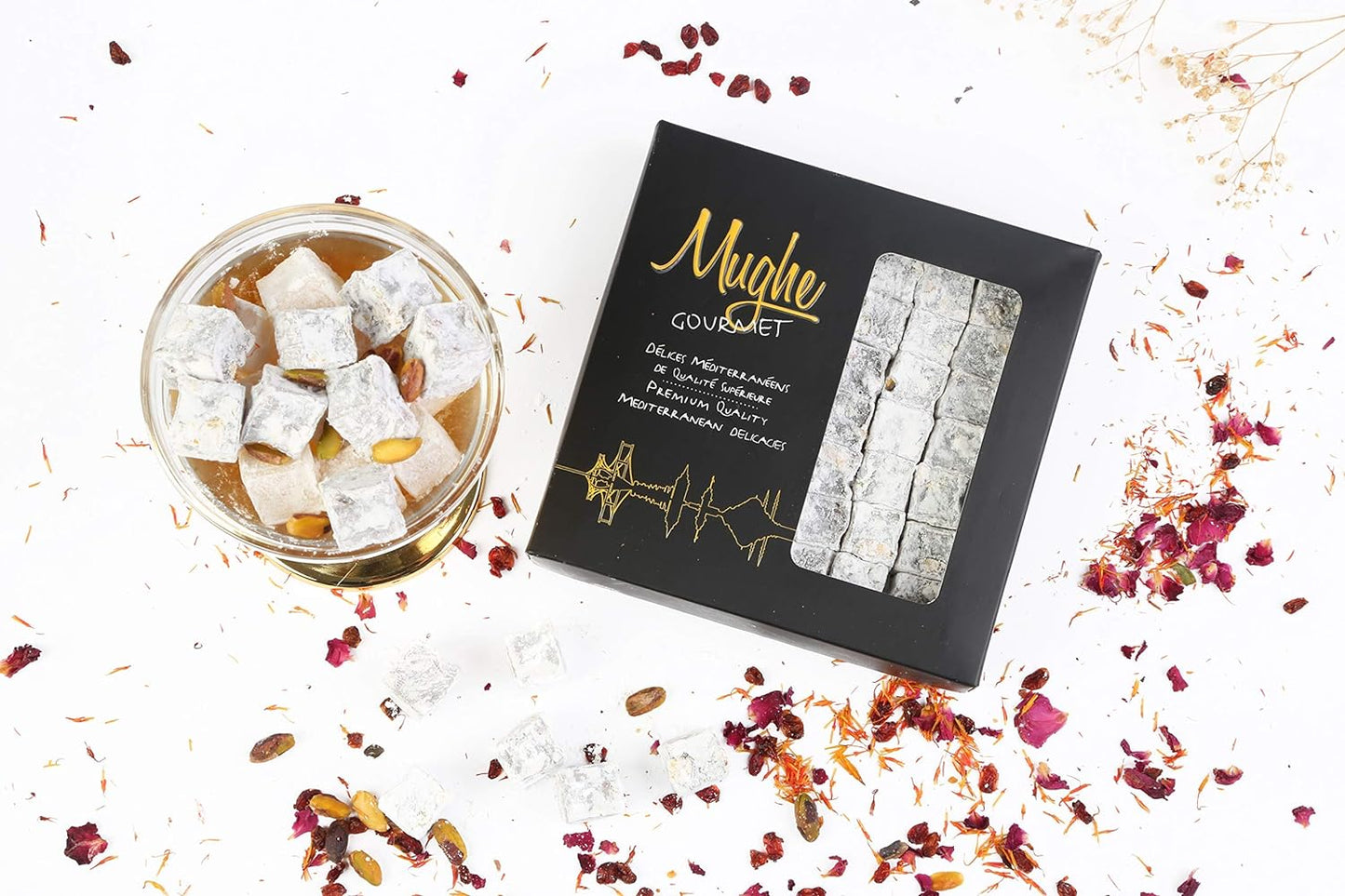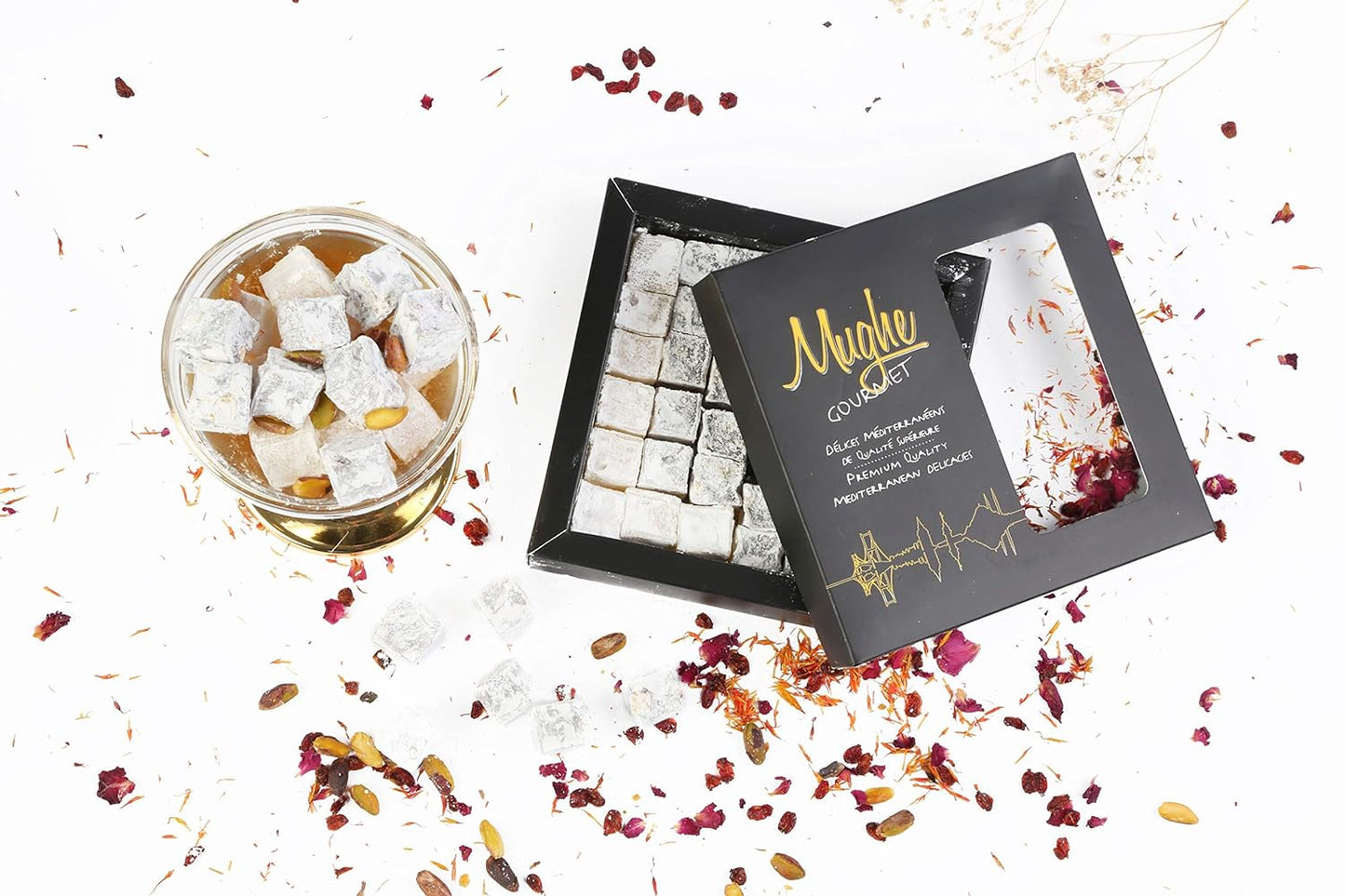

All Mughe Gourmet Turkish Delights are gluten-free , all Mughe Delights are vegetarian, all Turkish Delights without chocolate are VEGAN.
All Mughe Gourmet Turkish Delights are gluten-free , all Mughe Delights are vegetarian, all Turkish Delights without chocolate are VEGAN.
What is Turkish Delight?
Also known as lokum in Turkish, Turkish delight is a soft, chewy confection made from a gel of starch and sugar. It's often flavored with various ingredients like:
- Rosewater: A classic and popular flavor that offers a floral and delicate sweetness.
- Lemon: Provides a refreshing and tangy taste.
- Pistachio: Adds a nutty and slightly savory dimension.
- Orange blossom water: Offers a floral citrusy aroma and flavor.
- Pomegranate: Infuses the dessert with a sweet and tart taste profile.
These are just a few examples, and Turkish delight can be found in a wide variety of flavors, including fruit-based variations, such as fig, apricot, and cherry.
What are Turkish Delights Like?
Turkish delights are typically:
- Soft and chewy: Due to the gel base, they have a unique texture that is both soft and slightly resistant to biting.
- Sweet: Sugar is a main ingredient, but the sweetness level can vary depending on the flavor and brand.
- Fragrant: The use of spices and floral waters adds a distinct and aromatic element.
- Often dusted with powdered sugar: Adding a subtle sweetness and a slight crunch.
- Sometimes rolled in nuts: Adding another layer of texture and flavor, such as pistachios or coconut.
What is Turkish Delight?
Also known as lokum in Turkish, Turkish delight is a soft, chewy confection made from a gel of starch and sugar. It's often flavored with various ingredients like:
- Rosewater: A classic and popular flavor that offers a floral and delicate sweetness.
- Lemon: Provides a refreshing and tangy taste.
- Pistachio: Adds a nutty and slightly savory dimension.
- Orange blossom water: Offers a floral citrusy aroma and flavor.
- Pomegranate: Infuses the dessert with a sweet and tart taste profile.
These are just a few examples, and Turkish delight can be found in a wide variety of flavors, including fruit-based variations, such as fig, apricot, and cherry.
What are Turkish Delights Like?
Turkish delights are typically:
- Soft and chewy: Due to the gel base, they have a unique texture that is both soft and slightly resistant to biting.
- Sweet: Sugar is a main ingredient, but the sweetness level can vary depending on the flavor and brand.
- Fragrant: The use of spices and floral waters adds a distinct and aromatic element.
- Often dusted with powdered sugar: Adding a subtle sweetness and a slight crunch.
- Sometimes rolled in nuts: Adding another layer of texture and flavor, such as pistachios or coconut.
Sweetness: Naturally, sugar is a major component, making it a sweet treat. However, the sweetness level can vary depending on the flavor and brand. For instance, rosewater versions might be more subtly sweet compared to fruit-flavored varieties.
Texture: The primary sensation is softness and chewiness. The starch and sugar combine to create a gel-like base that has a slight resistance when bitten into.
Flavor: This is where the magic happens! Turkish delight comes in a diverse range of flavors, each adding its own unique taste:
- Rosewater: The most classic flavor, offering a floral and delicate sweetness. Imagine a light, fragrant rose aroma translated into a subtle taste.
- Citrus: Flavors like lemon or orange blossom water offer a refreshing and tangy taste that complements the sweetness.
- Nutty: Pistachio, hazelnut, or other nut inclusions add a rich and slightly savory dimension to the sweetness.
- Fruity: Flavors like pomegranate, fig, cherry, or apricot introduce a variety of sweet and tart profiles, adding another layer of complexity.
Additional elements:
- Spices: Some varieties might incorporate spices like cinnamon or cardamom, adding subtle warmth and depth.
- Floral notes: Apart from rosewater, some flavors might hint at other floral aromas, like orange blossom or lavender.
Overall experience:
Combining these elements, the taste of Turkish delight is a unique and enjoyable experience. It's a balance of sweetness, with different flavor profiles depending on the variety, all wrapped in a soft and slightly chewy texture.
Remember:
Taste is subjective, and individual experiences might vary! The best way to truly understand how Turkish delight tastes is to try it yourself and discover your own favorite flavors.
Sweetness: Naturally, sugar is a major component, making it a sweet treat. However, the sweetness level can vary depending on the flavor and brand. For instance, rosewater versions might be more subtly sweet compared to fruit-flavored varieties.
Texture: The primary sensation is softness and chewiness. The starch and sugar combine to create a gel-like base that has a slight resistance when bitten into.
Flavor: This is where the magic happens! Turkish delight comes in a diverse range of flavors, each adding its own unique taste:
- Rosewater: The most classic flavor, offering a floral and delicate sweetness. Imagine a light, fragrant rose aroma translated into a subtle taste.
- Citrus: Flavors like lemon or orange blossom water offer a refreshing and tangy taste that complements the sweetness.
- Nutty: Pistachio, hazelnut, or other nut inclusions add a rich and slightly savory dimension to the sweetness.
- Fruity: Flavors like pomegranate, fig, cherry, or apricot introduce a variety of sweet and tart profiles, adding another layer of complexity.
Additional elements:
- Spices: Some varieties might incorporate spices like cinnamon or cardamom, adding subtle warmth and depth.
- Floral notes: Apart from rosewater, some flavors might hint at other floral aromas, like orange blossom or lavender.
Overall experience:
Combining these elements, the taste of Turkish delight is a unique and enjoyable experience. It's a balance of sweetness, with different flavor profiles depending on the variety, all wrapped in a soft and slightly chewy texture.
Remember:
Taste is subjective, and individual experiences might vary! The best way to truly understand how Turkish delight tastes is to try it yourself and discover your own favorite flavors.



